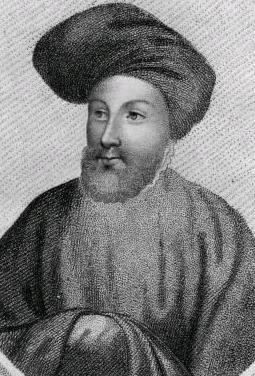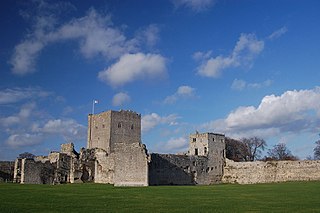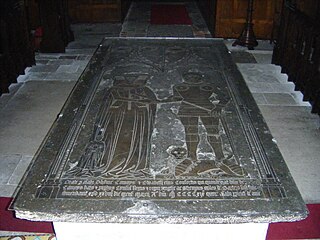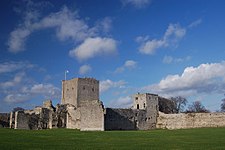
Edward, 2nd Duke of York, was an English nobleman, military commander and magnate. He was the eldest son of Edmund of Langley, 1st Duke of York, and a grandson of King Edward III of England. He held significant appointments during the reigns of Richard II, Henry IV, and Henry V, and is also known for his translation of the hunting treatise The Master of Game. He was killed in 1415 at the Battle of Agincourt, whilst commanding the right wing of the English army.

Richard of Conisbrough, 3rd Earl of Cambridge was the second son of Edmund of Langley, 1st Duke of York, and Isabella of Castile, Duchess of York. He was beheaded for his part in the Southampton Plot, a conspiracy against King Henry V. He was the father of Richard Plantagenet, 3rd Duke of York, and the grandfather of King Edward IV and King Richard III.
Anne de Mortimer was a medieval English noblewoman who became an ancestor to the royal House of York, one of the parties in the fifteenth-century dynastic Wars of the Roses. It was her line of descent which gave the Yorkist dynasty its claim to the throne. Anne was the mother of Richard, Duke of York, and thus grandmother of kings Edward IV and Richard III, great-grandmother of Edward V.

Edmund Mortimer, 5th Earl of March, 7th Earl of Ulster, was an English nobleman and a potential claimant to the throne of England. A great-great-grandson of King Edward III of England, he was heir presumptive to King Richard II of England when he was deposed in favour of Henry IV. Edmund Mortimer's claim to the throne was the basis of rebellions and plots against Henry IV and his son Henry V, and was later taken up by the House of York in the Wars of the Roses, though Mortimer himself was an important and loyal vassal of Henry V and Henry VI. Edmund was the last Earl of March of the Mortimer family.

Ralph Neville, 1st Earl of WestmorlandEarl Marshal, was an English nobleman of the House of Neville.

Roger de Mortimer, 4th Earl of March, 6th Earl of Ulster was an English nobleman. He was considered the heir presumptive to King Richard II, his mother's first cousin.
Constance of York, Countess of Gloucester was the only daughter of Edmund of Langley, 1st Duke of York, and his wife Isabella of Castile, daughter of King Peter of Castile and his favourite mistress, María de Padilla.

Henry Scrope, 3rd Baron Scrope of Masham KG, also known in older sources as Lord Scrope was a favourite of Henry V, who performed many diplomatic missions. He was beheaded for his involvement in the notional Southampton Plot to assassinate the king. Some historians believe that the charge was trumped-up to punish him for other acts of disloyalty, and that there may never have been such a plot.

Sir Thomas Grey, of Heaton Castle in the parish of Norham, Northumberland, was one of the three conspirators in the failed Southampton Plot against King Henry V in 1415, for which he was executed.

Isabella of Castile, Duchess of York was the daughter of King Peter and his mistress María de Padilla. She accompanied her elder sister, Constance, to England after Constance's marriage to John of Gaunt, 1st Duke of Lancaster, and married Gaunt's younger brother, Edmund of Langley, 1st Duke of York.
Isabel of Cambridge, Countess of Essex was the only daughter of Richard, 3rd Earl of Cambridge, and Anne de Mortimer. She was the sister of Richard Plantagenet, 3rd Duke of York, and like him a great-grandchild of Edward III of England.

Thomas de Camoys, 1st Baron Camoys, KG, of Trotton in Sussex, was an English peer who commanded the left wing of the English army at the Battle of Agincourt in 1415.

Margaret Stafford was the daughter of Hugh de Stafford, 2nd Earl of Stafford, and Philippa de Beauchamp. She was the first wife of Ralph Neville, 1st Earl of Westmorland, and the grandmother of the 2nd Earl.
William Grey was Bishop of London and then Bishop of Lincoln.

Richard de Vere, 11th Earl of OxfordKG was the son and heir of Aubrey de Vere, 10th Earl of Oxford. He took part in the trial of Richard, Earl of Cambridge, and Lord Scrope for their part in the Southampton Plot, and was one of the commanders at Agincourt in 1415.
Alianore Holland, Countess of March was the eldest daughter of Thomas Holland, 2nd Earl of Kent, and the wife of Roger Mortimer, 4th Earl of March, heir presumptive to her uncle, King Richard II. Through her daughter, Anne Mortimer, she was the great-grandmother of the Yorkist kings Edward IV and Richard III. She was governess to Richard II's wife, Isabella of Valois.
Richard le Scrope was an English cleric who served as Bishop of Coventry and Lichfield and Archbishop of York and was executed in 1405 for his participation in the Northern Rising against King Henry IV.

Elizabeth Mortimer, Lady Percy and Baroness Camoys, was a medieval English noblewoman, the granddaughter of Lionel of Antwerp, 1st Duke of Clarence, and great-granddaughter of King Edward III. Her first husband was Sir Henry Percy, known to history as 'Hotspur'. She married secondly Thomas Camoys, 1st Baron Camoys. She is represented as 'Kate, Lady Percy,' in Shakespeare's Henry IV, Part 1, and briefly again as 'Widow Percy' in Henry IV, Part 2.

John Grey, 1st Earl of Tankervillejure uxoris6th Lord of Powys, KG, was an English peer who served with distinction in the Hundred Years' War between England and France under King Henry V.

Sir Edward Courtenay was the eldest son of Edward de Courtenay, 11th Earl of Devon. He fought at Agincourt, and was killed in a sea battle in Henry V's continuing campaigns in Normandy.










